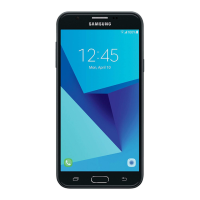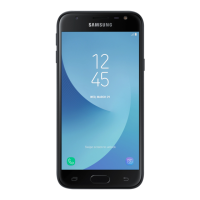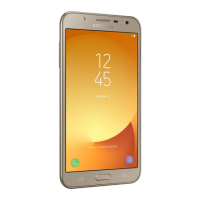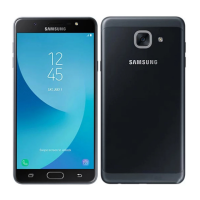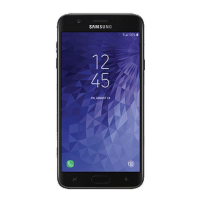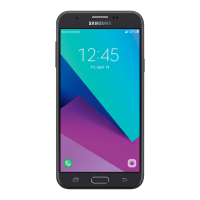Do you have a question about the Samsung J7 Star and is the answer not in the manual?
Virtual assistant that learns routines, sets reminders, and integrates with apps.
Device camera with unique features for capturing images and videos.
Use face unlock for device security; further info on flexible security.
Expand device storage using a compatible microSD card.
Darker theme for comfortable viewing in low light conditions.
Identifies and labels the front components of the device.
Identifies and labels the rear components of the device.
Instructions for inserting SIM/microSD cards and charging the device.
Steps to turn the device on/off and restart it.
Guides through initial device setup, language, Wi-Fi, and accounts.
Instructions on using Smart Switch to transfer data from another device.
How to secure the device using screen lock features and unlock the screen.
Set up and manage email, Google, and Samsung accounts for device features.
Steps to set up voicemail service using the Phone app.
Explains touch screen interaction methods like tap and double-tap.
Instructions for swiping to unlock the device or scroll through screens.
How to move items like app shortcuts or widgets on the Home screen.
How to use thumb and forefinger gestures to zoom on the screen.
How to activate items, display options, or customize the Home screen.
Personalize the device's Home screen layout, icons, folders, and wallpapers.
Customize Home and Apps screens, layout, grids, badges, and more.
Switch to a simpler layout with larger text and icons for easier use.
Explains device information and notification alerts on the Status bar.
Access notifications and quick settings by opening the Notification panel.
How to access and interact with the Notification panel and quick settings.
Integrates with Camera, Gallery, and Internet for deeper understanding of visual content.
Use biometrics like face recognition for secure unlocking and account access.
Customize face recognition settings like unlock, faster recognition, and screen brightness.
Configure preferences for biometric security options, like transition effects.
Access clipboard, emojis, GIFs, stickers, and text editing tools from the keyboard.
Customize keyboard settings like languages, smart typing, and layout.
Enter text by speaking, with options to configure language and offline recognition.
Access emergency features and conserve power during emergencies.
Access preloaded and downloaded apps from the Apps list.
Remove or disable installed apps from your device.
Use the Finder search feature to locate apps and settings.
Arrange app shortcuts alphabetically or in a custom order.
Organize app shortcuts into folders for better management.
Manage downloaded and preloaded apps, sort them, and set default apps.
Control which device features apps can access when running in background or foreground.
Monitor app permission usage and receive notifications for changes.
Send diagnostic information to Samsung for technical problem troubleshooting.
Information on Samsung-specific apps like Galaxy Essentials and Store.
Create notes with text, images, voice recordings, and share them.
Control, automate, and monitor your home environment via the mobile device.
Features basic/scientific math functions and a unit converter.
Consolidate calendars from online accounts and create events.
Capture high-quality pictures and videos using the device's camera.
Store and manage contacts, synchronize with personal accounts.
Features for keeping track of time and setting alarms.
View and manage multiple email accounts in one application.
View, edit, and manage pictures and videos stored on your device.
Browse the web with secure features like Secret Mode and Contents Blocker.
Communicate with contacts by sharing photos, emojis, and messages.
View and manage files like images, videos, music, and sound clips.
Make calls, explore advanced calling features, and access voicemail.
Overview of Google applications like Chrome, Drive, Duo, Gmail, and Google Search.
Apps requiring a data plan or subscription, provided by your carrier.
Information on preloaded or downloaded third-party applications.
Ways to access device settings via Status bar or Apps.
Find specific settings by using the search function.
Manage network and device connections, including Wi-Fi and Bluetooth.
Connect to Wi-Fi networks for internet access without using mobile data.
Connect to Wi-Fi networks not listed by manually entering information.
Configure Wi-Fi connections, hotspots, saved networks, and addresses.
Share data between devices using Wi-Fi Direct.
Pair with Bluetooth devices like headphones or vehicles.
Change the name of a paired Bluetooth device for easier recognition.
Disconnect a paired Bluetooth device.
Configure media volume sync, ringtone sync, and Bluetooth history.
Make the device discoverable by other Bluetooth devices.
Communicate with devices using NFC for data transfer and payments.
Share data between NFC-enabled devices using Android Beam.
Make payments by touching the device to compatible readers.
Disconnect from all networks and turn off connectivity features.
Configure mobile network connections and data usage.
Monitor and customize mobile and Wi-Fi data usage, including warnings and limits.
Reduce data consumption by limiting background data usage for apps.
Customize mobile data access, set limits, and view usage.
Restrict Wi-Fi data access by customizing usage limits and networks.
Create a Wi-Fi network using the device's data plan for multiple devices.
Customize the password for your mobile hotspot.
Create a list of devices permitted to connect to your mobile hotspot.
Customize hotspot security and connection settings like network name and security type.
Share your Wi-Fi network with other devices without revealing the password.
Share the device's internet connection with another device via USB.
Easily connect to available devices by turning on scanning.
Print documents and images from your device to a printer.
Connect to a private secured network using VPN.
Edit or delete a configured VPN connection.
Establish and disconnect from a VPN connection.
Configure device connection to a private DNS host.
Control sounds and vibrations for notifications, screen touches, and interactions.
Change sound mode (Sound, Vibrate, Mute) without using volume keys.
Quickly mute sounds by covering the screen or turning the device over.
Control how and when the device vibrates, including patterns and intensity.
Adjust volume levels for ringtones, notifications, and audio.
Set volume keys to control media volume by default.
Limit maximum output volume when using headphones or Bluetooth speakers.
Customize call ringtone by selecting preset sounds or adding audio files.
Customize sounds for screen taps, charging, keypad tones, and keyboard actions.
Experience enhanced audio quality for content mixed for Atmos.
Choose audio presets or manually adjust audio settings for music genres.
Enhance sound resolution with UHQ upscaler, Tube Amp Pro, or Concert hall.
Customize sound for each ear and enhance listening experience.
Play media sound on a separate audio device for a chosen app.
Prioritize and streamline app alerts, manage notifications per app.
Configure notifications, app icon badges, and Do Not Disturb settings.
Change notification settings for individual apps, including categories.
Get notified about missed calls/messages by vibrating when the device is picked up.
Configure screen brightness, timeout, font size, and other display settings.
Adjust screen brightness manually or adapt it automatically to lighting conditions.
Reduce blue light for better sleep, with scheduling options.
Switch to a darker theme for comfortable viewing at night.
Adjust screen quality for different situations using various screen modes.
Change font size, style, and download new fonts from Galaxy Store.
Adjust the zoom level to increase or decrease content size on the screen.
Set the duration before the screen turns off automatically.
Prevent unintended screen touches in dark places like pockets or bags.
Display colors or photos when the screen turns off or while charging.
Decrease motion effects, such as when opening apps.
Change screen layout for easier operation with one hand using gestures or buttons.
View device status, optimize performance, and scan for malware.
Improve device performance by clearing memory and closing background apps.
Monitor battery usage, select power modes, and configure advanced settings.
View device storage, mount/unmount memory cards, and format SD cards.
Optimize device storage and increase available memory.
Information about microSD cards and their display in storage settings.
Steps to mount an optional memory card for access.
Unmount and remove an optional memory card safely.
Format an SD card, backing up data first as it erases all files.
Check available memory, close background apps, and free up memory.
Configure device language, input methods, and keyboard settings.
Add and set preferred languages for the device interface.
Select a default keyboard for menus and input.
Use voice input for text entries and configure related settings.
Enable or disable on-screen keyboards.
Customize options for connected physical keyboards.
Save time by using autofill services for information entry.
Configure Text-to-Speech options for accessibility features.
Adjust pointer speed for optional mice or trackpads.
Define the primary mouse button preference.
Set date and time manually or automatically, and choose 24-hour format.
Check for software updates and reset services on the device.
Check for and install available software updates for the device.
Reset device settings, network settings, or accessibility settings.
Reset device to factory defaults, excluding security, language, and account settings.
Reset Wi-Fi, mobile data, and Bluetooth settings.
Reset device accessibility settings.
Optimize device by automatically restarting at set times.
Reset device to factory defaults, erasing all data.
Protects device if reset without permission; requires Google Account credentials.
Automatically activates FRP security when adding a Google Account.
Remove Google Accounts to disable FRP security.
Collect diagnostic data for troubleshooting and personalized offers.
Secure your device and protect data by setting a screen lock.
Choose lock types (Swipe, Pattern, PIN, Password) for device security.
Recommended steps to set up a Pattern, PIN, or Password for security.
Configure features on the Lock screen, like clock style and contact information.
Regularly check apps and device for security risks and threats.
Protect device from loss/theft by locking, tracking, and remote data deletion.
Enable and customize Find My Mobile features for remote device access.
Check for and install the latest security software updates.
Allow installation of third-party apps from selected sources.
Create a secure folder to protect private content and apps.
Require PIN, pattern, or password when the device is turned on.
Encrypt optional memory card data for secure access with a password.
Decrypt memory card data if it was previously encrypted.
Set a PIN to lock the SIM card and prevent unauthorized use.
Make characters in password fields briefly visible while typing.
Set device to automatically check for security updates.
Authorize security features and apps for administrative access.
Manage trusted security certificates for secure connections.
Configure advanced settings like trust agents and pinned apps.
Configure location services, Wi-Fi, and Bluetooth scanning for accuracy.
View apps that have recently requested location data.
Understand how location services store and use your device's location data.
Control which device features apps can access when running in background or foreground.
Monitor app permission usage and receive notifications for changes.
Send diagnostic information to Samsung for technical problem troubleshooting.
Connect to and manage Google, Samsung, email, and social networking accounts.
Add and sync email, social networking, and sharing accounts.
Configure custom settings for each account type.
Remove accounts from your device.
Back up, restore, and sync data with Samsung Cloud.
Configure backups for Samsung and Google accounts.
Configure your device's Google settings based on your Google Account.
Access settings for users needing visual, hearing, or dexterity assistance.
Navigate the device using spoken feedback and voice assistant controls.
Configure features for visual assistance, like colors, contrast, and zoom.
Adjust colors and contrast for text and screen elements for easier viewing.
Increase screen element size and create shortcuts for accessibility features.
Configure features for audial assistance, like sound quality and balance.
Adjust audio quality for hearing aids or earphones.
Convert speech to text and view closed captions for multimedia.
Configure features for users with limited dexterity.
Control the device using different input methods and controls.
Simplify motions for answering calls or responding to notifications.
Adjust screen sensitivity for taps and touches.
Customize additional accessibility features and services.
Configure accessibility settings to open quickly using hardware keys.
Customize notification alerts, flash notifications, and reminders.
Install additional assistance services for the device.
Configure features to make the device easier to use.
View the user manual on the device.
Organize games and access extra features with Game Launcher and Game Tools.
Use two separate accounts for the same app.
View device information, status, legal details, and hardware/software versions.
Access video tutorials and support content online.
Interactive tool to learn about device features.
Access helpful tips and guides for device usage.
Access support resources and services from Samsung.
Contact support via Facebook Messenger, Facebook, or Twitter.
Details on binding arbitration agreement and opt-out process.
Information on the standard one-year limited warranty for the device.
Terms and conditions for using the device's software.
Important health and safety guidelines for device usage.
View FCC approval and certification information for the device.
Samsung's security platform tested for enterprise use.
Set up parental controls to manage children's access to device services and content.
Company contact information and address.
| Display | 5.5 inches |
|---|---|
| Resolution | 720 x 1280 pixels |
| Processor | Exynos 7870 Octa |
| RAM | 2 GB |
| Internal Storage | 32 GB |
| Expandable Storage | microSD, up to 512 GB |
| Rear Camera Features | LED flash, panorama, HDR |
| Rear Camera Video | 1080p@30fps |
| Front Camera Video | 1080p@30fps |
| Operating System | Android 8.0 (Oreo) |
| SIM | Single SIM (Nano-SIM) or Dual SIM (Nano-SIM, dual stand-by) |
| Network Technology | GSM / HSPA / LTE |
| Launch Date | 2018, June |
| Build | Glass front, plastic back, plastic frame |
| Loudspeaker | Yes |
| 3.5mm jack | Yes |
| WLAN | Wi-Fi 802.11 b/g/n, Wi-Fi Direct, hotspot |
| Bluetooth | 4.2, A2DP, LE |
| GPS | Yes, with A-GPS, GLONASS, BDS |
| NFC | No |
| Radio | FM radio |
| USB | microUSB 2.0 |
| Sensors | Accelerometer, proximity |
| Models | SM-J737T, SM-J737T1 |
| Display Type | Super AMOLED |
| Rear Camera | 13 MP |
| Battery | 3300 mAh |
| Colors | Black, Blue |

